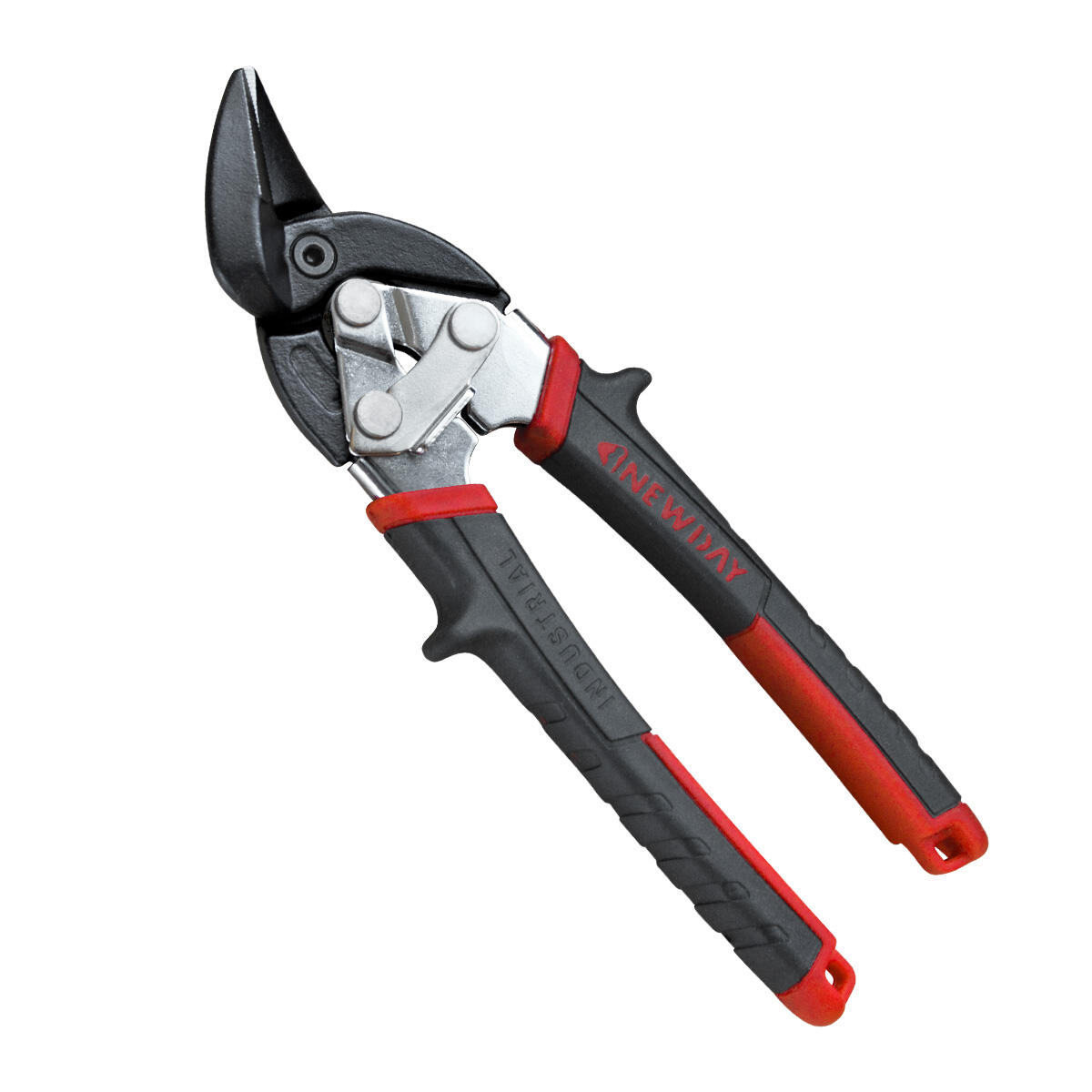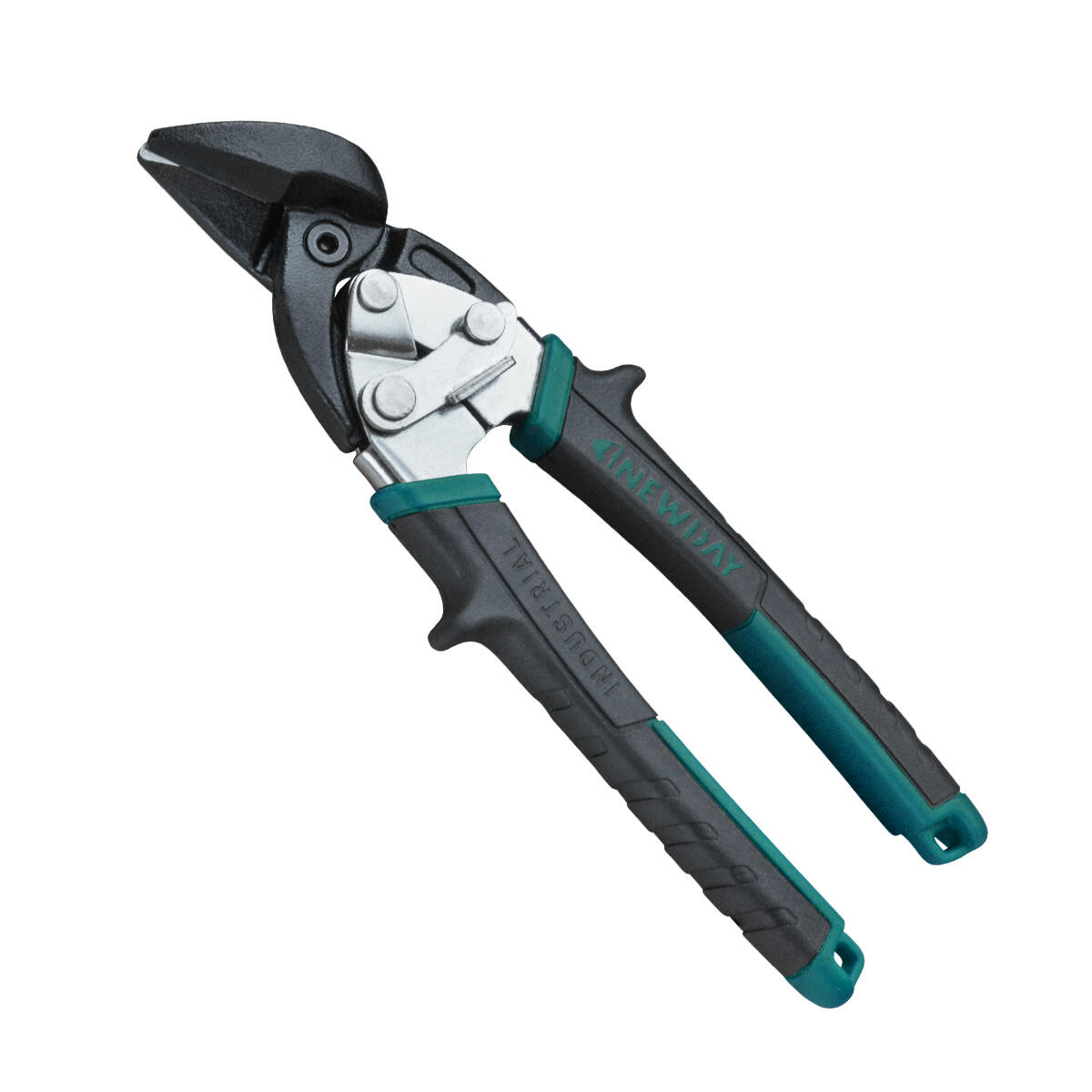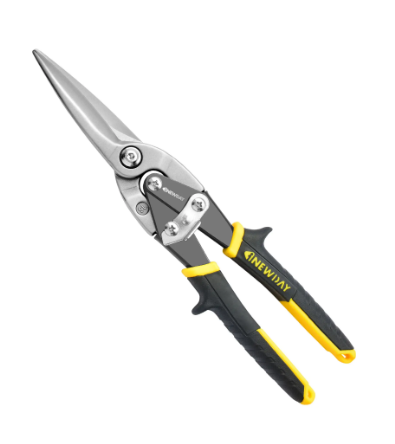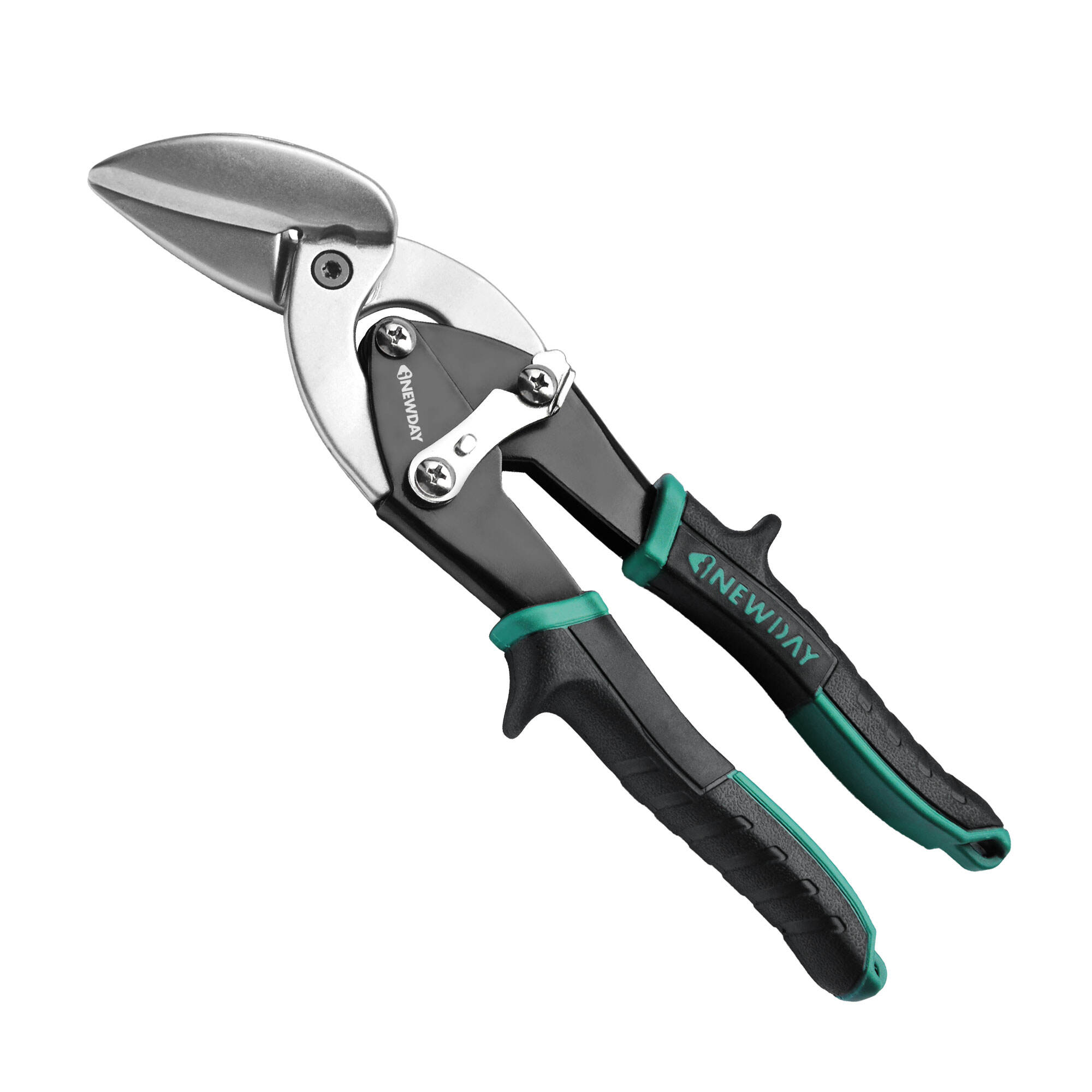Main Types of Aviation Snips
Understanding the various types of aviation snips is crucial to choose the right tool for your specific tasks. From straight to offset and vertical cuts, each type of snip serves distinct purposes, making them indispensable in metalworking, construction, and DIY projects.
Straight-Cut Aviation Snips (Yellow Handle)
Aviation snips with straight blades usually come with yellow handles and work great for cutting straight lines through different materials. These tools handle everything from aluminum to vinyl and even thin steel sheets pretty well. What makes them stand out is how versatile they are while still being easy to use, which explains why so many people keep a pair handy in their workshop. Sheet metal workers rely on them all the time, but homeowners tackling home improvement tasks find them indispensable too when accuracy matters most during installation jobs.
Left-Cut Aviation Snips (Red Handle)
Left cut aviation snips have those distinctive red handles that make them easy to spot on any job site. They work best when cutting materials to the left side, giving users much better control especially when working on curves or complex shapes. Craftspeople find these tools absolutely essential for detailed work where precision matters most, so they show up frequently in HVAC installations and automotive repair shops across the country. The handles feature non slip grips that help prevent tired hands during long sessions, which means workers get things done faster without compromising on safety standards throughout the process.
Right-Cut Aviation Snips (Green Handle)
Aviation snips with green handles are great for cutting to the right side, especially when working around those tricky corners that just won't give way. These tools handle all sorts of materials from tough steel to softer plastics, so they come in handy during car repair jobs where precision matters. Most models feature blades made from hardened steel, something that makes these snips last longer and work better over time. Mechanics love them, but even weekend warriors find these tools indispensable for getting through stubborn projects without breaking the bank on specialty equipment.
Offset Aviation Snips
Aviation snips with offset blades keep fingers away from the actual cut line, which makes them much safer to use. They work really well when cutting complicated shapes something most pros need when working on tricky jobs. The special design also gives these snips an edge in cramped areas where regular snips just don't reach. This means workers can tackle those awkward cuts without constantly struggling to get into position.
Mini Aviatiion Snips
Mini aviation snips come in handy when working in cramped spots or up high where regular tools just won't fit. They're small enough to carry around but still get the job done just like bigger snips would. Roofers love these little guys because they can cut through materials while standing on ladders all day long. Electricians find them invaluable too since wires often hide behind walls where full sized tools can't reach. And anyone else needing something portable yet powerful enough for real work will appreciate what these compact snips bring to the table.



Common Uses of Aviation Snips
Sheet Metal Fabrication
The main application area for aviation snips lies in sheet metal fabrication across various industries needing exact metal component shaping. What makes these tools so valuable is their ability to speed up production while still permitting last minute tweaks during actual fabrication work. When working with aviation snips, craftsmen get clean, accurate cuts essential for making sure those metal pieces fit together just right when assembled. Industry data shows around 30 percent of all metal fabrication operations depend on these specialized cutters because they deliver both speed and precision where it matters most. For shops dealing with complex metal part designs, having reliable aviation snips means the difference between wasted material and perfectly executed projects.
HVAC Ductwork Installation
HVAC technicians rely heavily on aviation snips when working with metal ductwork during heating and cooling system installations. These specialized cutting tools allow workers to slice through sheet metal with ease, making it possible to create custom fittings right at the job site. Getting those cuts just right matters a lot since even small mistakes can lead to leaks or poor airflow later on. Many contractors in the field have noticed that more and more companies are switching to aviation snips these days. The reason? They simply work faster and produce cleaner edges compared to other methods. When installers can make those sharp, accurate cuts without fuss, whole projects tend to go smoother. Nobody wants to spend extra time fixing botched measurements down the road after everything's already been put together.
Roofing and Flashing Projects
When working on roofing jobs or installing flashing, aviation snips become indispensable for cutting through materials such as metal flashing and sheet metal. Getting clean cuts really matters here since poor cuts can compromise how well the roof seals against water and maintains proper insulation. Most experienced roofers swear by aviation snips because they cut fast and straight, something that just cant be matched with regular tin snips when time is money on a job site. What sets these apart is their ability to handle all sorts of tricky angles and awkward shapes that pop up during actual installations, making the final work look better and last longer without leaks developing down the road.
Automotive Repair and Customization
Auto body shops rely heavily on aviation snips for all sorts of repair jobs and custom builds. These specialized cutters let technicians slice through sheet metal with the kind of precision needed when working on everything from minor dents to full panel replacements. When fabricating custom components like replacement fenders or door skins, having good aviation snips can mean the difference between a clean job and hours wasted fixing mistakes. Most garages will tell anyone who asks that around 60% of their daily work involves some form of sheet metal manipulation. The right pair of aviation snips keeps things moving smoothly on the bench while ensuring those custom cars look sharp when they roll out the door after a weekend project.
How to Choose Aviation Snips for Your Project
Matching Snip Type to Cutting Direction
Matching aviation snips to the cutting direction matters a lot when working on any project involving sheet metal. Before grabbing whatever pair looks handy, take time to figure out what exactly needs cutting. Different snip types handle different jobs, so picking the wrong one often means wasted time and plenty of headaches later on. Straight cut snips work great for those long straight edges everyone wants so badly, but if there are curves or awkward angles involved, then left hand or right hand models become indispensable tools. Most experienced workers know this already from years of trial and error. When deciding which snip goes into the toolbox, always check both the material thickness and how complex those cuts really are. Getting this right makes all the difference between decent results and outstanding craftsmanship.
Understanding Handle Color Coding System
Aviation snips come with colored handles that serve as a handy visual guide for workers across different trades. These colors actually tell users which way the snip will cut when squeezed. Take it from experience: yellow handles make straight cuts, red ones go left, while green handles bend to the right side. Knowing these color meanings saves time on the job site and prevents accidents caused by using the wrong tool. Electricians, plumbers, and HVAC technicians especially appreciate being able to grab the right snip at a glance without having to read tiny labels every time they need to make a cut.
Ergonomic Features for Prolonged Use
When choosing aviation snips, paying attention to ergonomic design makes all the difference when working long hours. Good quality snips should have handles and grips that spread out the pressure across the hand instead of concentrating it in one spot. Many workers find they can stay at their task much longer without getting that annoying ache in their palms that comes with cheaper, poorly designed tools. People who actually use these tools day in and day out often mention how much better padded grip models feel after several hours of cutting. Investing in ergonomics isn't just about comfort though it really does boost productivity too, particularly when tackling those tough jobs where the tool needs to be in constant motion for extended periods.
Maintenance and Safety Best Practices
Proper Cleaning and Lubrication
Keeping aviation snips in good working order means doing some basic maintenance regularly. Cleaning them consistently stops rust from forming and maintains those sharp cutting edges so they work properly when needed. One thing worth remembering is applying lubricant to the pivot points. This simple step makes a big difference in how well the snips perform and how long they last before needing replacement. The lubrication cuts down on friction where the parts move against each other. Tools maintained this way tend to stay reliable for much longer periods, saving money in the long run since replacements aren't necessary as often.
Safe Handling Techniques
When working with aviation snips, keeping safety front of mind is absolutely essential. Safety glasses are a must have during any cutting operation since those tiny metal pieces can really fly out unexpectedly and cause serious eye damage. Storing these tools properly matters too. Nobody wants to grab a pair only to get cut accidentally. Best practice? Keep them locked away in a sturdy toolbox or at least ensure the blades are closed tightly when not in use. Many shops now offer hands-on training sessions specifically for power tools and cutting equipment. These classes aren't just about avoiding injuries either. Workers who complete such programs tend to work faster and produce better results because they understand exactly how each tool functions safely and efficiently.
Blade Sharpening and Replacement
Checking how well blades are holding up over time makes all the difference when it comes to getting good results from any cutting task. When something starts feeling harder to cut through than normal, this often means either sharpening or swapping out old blades becomes necessary pretty soon. Signs that blades aren't performing right include things like becoming dull or developing rough spots along their edges. Most manufacturers actually provide pretty detailed guidance on proper ways to keep blades sharp enough for continued use. But there definitely comes a point where no amount of sharpening can bring back lost effectiveness. At that stage, investing in new blades remains the smartest choice if maintaining both accuracy and workplace safety matters at all.
FAQ Section
What are aviation snips used for?
Aviation snips are used for cutting metal sheets and other materials in industries like construction, automotive, and HVAC.
How do I choose the right aviation snip for my project?
Choose aviation snips based on the cutting direction required for your project, indicated by the handle's color coding.
How often should aviation snips be maintained?
Aviation snips should be cleaned and lubricated regularly to maintain their efficiency and longevity.
Can aviation snips be used on plastic materials?
Yes, aviation snips can cut various materials, including plastic, steel, and aluminum.







